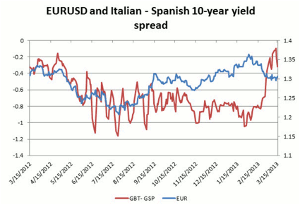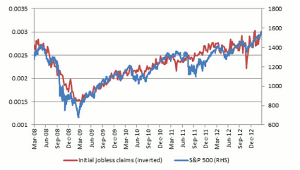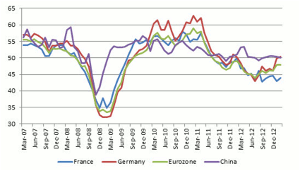Kathleen Brooks and Eric Viloria, CMT, of Forex.com highlight the events and indicators likely to shape the forex markets this week.
No White Smoke from the EU Summit
European officials could learn a thing or two from the Vatican who elected a new pope last week. If you want EU officials to make a decision rather than just be a talking shop, lock them in a room and don’t let them out until agreement has been reached. They didn’t take this approach, probably some egregious health and safety law prevents them from doing so, thus we come away from another EU summit without any solutions to the economic problems plaguing the Eurozone. Added to that, at the time of writing, it was looking less likely that Cyprus would receive a bailout.
There was certainly debate about growth vs. austerity, but even before the summit began the parameters of the debate seemed to be set, Germany’s 2013/14 budget was lauded by Berlin as an example of how fiscal consolidation could also support economic growth. It’s a mere six months until Chancellor Merkel faces federal elections and her Christian Democrat party has suffered heavy losses in regional elections, thus it is doubtful if Berlin went to the summit in any mood to disband with the fiscal pact.
Although fiscal slippage will be tolerated, France said earlier this week that its deficit would miss the 3% target for 2013; it is unlikely this will stimulate growth. Added to that, loans from the European Investment Bank to tackle youth unemployment are expected to be fairly small in size. There seems to be no strategy for growth in the Eurozone. Individual governments in the periphery are concerned about meeting fiscal targets, while in the Northern bloc they are trying to protect their taxpayers’ money from bailouts. This is a serious disconnect, and this summit once again highlights how the ECB will need to continue to be ready to provide financial support to struggling banks and sovereigns for many years yet. Thus, a shrinking ECB balance sheet may not last long.
The political damage of the sovereign crisis was brought back into focus on Friday as the Italian Parliament met for the first time since last month’s inconclusive election. There is no government, and no side looks like they can form even a minority government. This raises the prospect of another round of elections; however they could be many months away. If new elections are called it increases the risk that an anti-Europe party could win power, thus elevating break-up risk within the currency bloc.
Fears that Germany would turf Greece out of the currency bloc caused the markets to nosedive; so far the Italian election impasse has barely caused markets to blink. However, new elections, a sizable win for the Five Star Movement and the threat of Italy leaving the currency bloc of its own accord (rather than out of duress) could cause the edifice of stability to crack and bond yields to surge as people worry that Italy is too big for even the ECB to save.
In this environment of political impasse in Italy but little market reaction, it requires investors to be vigilant none the less. The key indicator is the Italian-Spanish bond spread. As you can see below, the spread has widened, as Italian bond yields have out-paced gains in Spanish yields. This spread is also worth watching if you trade FX. EUR/USD appears to have developed an inverse correlation to this spread, so as Italian yields rise faster than Spain’s the euro drops.
EUR/USD may have ended the European session above 1.30 last Friday, but the rally is still fragile, and the inability of EUR/USD to extend gains above 1.31 is concerning. From a technical perspective, below 1.3295, the base of the Ichimoku cloud, is still a downtrend. Thus, this may be a corrective move higher, rather than the start of a new trend. We tend to think that the euro will trade in a range in the medium-term, support in EUR/USD lies at 1.2870, the 200-day sma. However, the euro is at risk from a sell-off if the sizable political concerns on the horizon lead to an all-out flare up of the sovereign crisis. Thus, we are fairly neutral on the euro in the short term, in the medium term we are looking for further weakness, as a rising dollar and sovereign risk weigh on the single currency.
Figure 1

Source: Bloomberg, FOREX.com
Click
to Enlarge
UK Budget Preview
The Chancellor George Osborne will deliver the 2013/14 Budget on Wednesday March 20. The market expects this budget to remain fiscally neutral. Although he faces stiff opposition, we expect Osborne will stick to his fiscal targets and won’t announce any new fiscal giveaways. We expect growth forecasts to be revised down a notch and for 2012/13 public sector borrowing to be revised higher by GBP5 billion, which will be a climb down for Osborne who said this would not happen back in the pre-budget statement in December. Apart from this, we expect Osborne to announce a couple of things that could move the markets.
The first is a review into the BOE’s remit. It is unclear at this stage what the parameters of the review will be; it is likely designed to help increase the BOE’s scope to ease monetary policy going forward. This review might be done in time before the new Governor, Mark Carney, takes the helm at the BOE on July 1.
The second could be an enhanced Funding for Lending scheme, perhaps more credit will be available on even better terms to try and get banks’ lending to SME’s. As we have said before, one of the biggest problems with the FLS is that business confidence levels are low in the UK, which reduces demand for loans, even if they are cheap. We have also said that tight fiscal policy combined with lose monetary policy doesn’t stimulate the economy as the government and the central bank end up pulling in opposite directions. This is in contrast to Japan, where lose fiscal and monetary policy are supporting each other to boost growth.
NEXT PAGE: FOMC in Focus
|pagebreak|Overall, we think that the budget could be mildly sterling bearish as it is unlikely to boost growth making a triple dip more likely. However, the caveat is that Osborne surprises the market and announces growth-boosting measures. A tax cut or a boost to capital spending could cause the pound to rally on the back of an expected pick-up in growth.
Sterling managed to regain some recent losses last week and closed above 1.50 on Friday. However, we think this is a temporary pullback and sellers will re-emerge, especially if we get dovish minutes from the March BOE meeting, also released on Wednesday. BOE governor King said last Thursday that the pound had fallen far enough in a TV interview. While we think a weaker pound is likely to hurt growth, due to its impact on inflation and erosion of consumer purchasing power, we don’t think that King will be able to stem the tide of bearish sentiment against the pound for long. Instead, the pace of future declines may start to slow. 1.5250 is a major resistance level, while 1.4950 is short-term support.
FOMC in Focus
The Federal Open Market Committee will meet next week and on Wednesday, March 20, the FOMC will announce policy, release an updated summary of economic projections, and Chairman Bernanke will hold a press conference. This past week, the Fed announced a time change for the statement and news conference to reduce the amount of time in between. The FOMC statement and economic projections will be released at 1400ET and conference will begin at 1430ET. This is seen as an attempt to improve transparency and reduce market volatility as the statement is interpreted by market participants. Instead, it allows the Chairman to further clarify the Bank’s position on monetary policy and the economic outlook.
With no change in policy expected, the focus will be on the tone of the statement and updated economic outlook. Since the last meeting, economic data has improved notably with significant upward revisions and improvement in labor market data in particular. Labor market improvement has also been a notable driver of risk appetite (see chart below) and has been supportive of the USD from a monetary policy perspective. The consumer has been resilient as indicated by a strong rise in retail sales while industrial production has increased significantly as well. While some members of the Fed have indicated a preference for a tapering of asset purchases, the majority in the voting committee has remained dovish. St. Louis Fed President Bullard (FOMC voter) has been vocal in his calls for a reduction in the pace of QE, however it is not clear the extent of support he has received from the FOMC.
Bernanke recently said that the FOMC intends to sustain easing as long as needed until there are substantial labor market gains and added that timing the end of accommodation will be a challenge. Though he has defended QE and maintained his dovish stance, the Chairman seems more cautious with regards to monitoring the costs vs. benefits of QE. If the costs of additional purchases outweigh the benefits, then the Fed is more likely to shift away from QE. In our view, this is not imminent but may occur later in the year if the outlook for employment continues to improve.
The most dovish member of the FOMC, Evans, has indicated that he would want to see NFP growth of at least 200k per month for six months before tapering asset purchases. Three out of the past four months have seen NFP prints over 200k and the four-month average is around 205k.
If the Fed is viewed as less dovish, then the USD may resume its current rally. The dollar may gain support if there is an end in sight to QE, while expectations of prolonged asset purchases would likely weigh on the greenback.
Figure 2

Source: Bloomberg, FOREX.com
Click
to Enlarge
Global PMI’s May Show Improvement
Several purchasing managers’surveys are due out next week in countries such as China, Germany, France, and the Eurozone as a whole. PMI’s are significant as they tend to be reliable leading indicators of growth. A reading above 50 indicates expansion while a sub-50 print indicates contraction in the sector surveyed.
On Tuesday, China will see its unofficial flash manufacturing PMI for March, which is expected to improve to 50.9 from 50.4. The decline to 50.4 in February was below estimates, however it is likely that Chinese New Year negatively impacted the report. As such, we expect to see a rebound to indicate a strengthening recovery in manufacturing. Economic data out of China tends to impact the AUD as the Australian economy is closely tied to that of China. Therefore a positive reading may benefit the AUD, while a disappointing print would have the opposite impact. Technically, AUD/USD has rallied significantly to test the pivotal 100-day simple moving average (SMA) which is around the 1.04 figure. The 200-day SMA is just below at about 1.0360 and a break of either SMA is likely to see some follow through.
Europe will see both services and manufacturing PMI’s for March out of France, Germany, and the Eurozone on Tuesday as well. Forecasts are for Germany to show expansion (above 50), the Eurozone composite PMI is anticipated to improve to 48.2 from 47.9 and France’s PMI is expected to move slightly higher but remain well below the 50 level. The data may show that the region remains in a contraction, however the pace of deterioration in activity may be slowing if the data ticks higher. Key technical levels to watch in EUR/USD in the week ahead are the 100-day SMA around 1.3130 and the 200-day SMA around 1.2870.
Figure 3

Source: Bloomberg, FOREX.com
Click
to Enlarge
Overall, markets appear to be optimistic with regards to March PMI’s and this may see a continued improvement in risk appetite.
By Kathleen Brooks and Eric Viloria, CMT, of Forex.com





















